Nowadays, kitchen appliances play a crucial role in helping us prepare meals quickly and efficiently. In recent years, two kitchen appliances have gained significant attention: the air fryer and the microwave. Both of them serve slightly different purposes, but there is a growing curiosity about whether an air fryer can replace a microwave oven.
In this article, we will delve into the functionalities of air fryers, examine their potential to replace microwaves and explore the key differences between these two appliances and decide, can an air fryer replace a microwave or not.
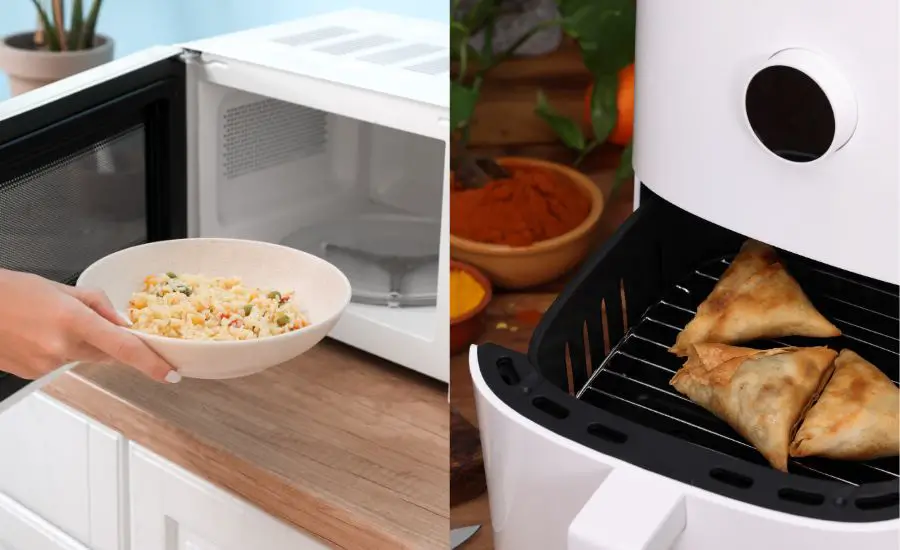
Understanding what an air fryer is
Air fryers have gained popularity due to their ability to cook food using hot air circulation. By using rapid hot air circulation, the air fryer cooks food evenly and efficiently, often producing crispy results without the need for excessive oil.
While air fryers excel in cooking a wide range of dishes, they are particularly praised for their ability to prepare fried foods with reduced oil content.
Additionally, air fryers provide the option to cook various other foods, including reheating leftovers, chicken wings, and more.
The comparison between an air fryer and a microwave is frequently made, with many people wondering ‘Can an air fryer replace a microwave oven?’
Answering this question necessitates a careful examination of their respective features.
While both appliances have distinct functions, the air fryer is typically seen as a versatile alternative.
It can cook food more efficiently, resulting in crispy textures and enhanced flavors.
However, it is important to note that certain microwave-specific functionalities, such as heating liquids and microwave-specific cooking food methods, cannot be replicated by an air fryer.
An air fryer works similarly to a convection oven by utilizing the circulation of hot air within the air fryer basket through its heating element. In contrast, a microwave oven relies on electromagnetic radiation as its primary method to heat food.
While the air fryer does not replace the traditional convection oven entirely, they offer a more compact and efficient option for certain cooking tasks.
Despite its ups, it is important to also remember the downs of an air fryer. There are some people who are worried that air fryer emit radiation – the radioactive background does exist here, but it is natural and is considered minimal in comparison to microwave ovens.
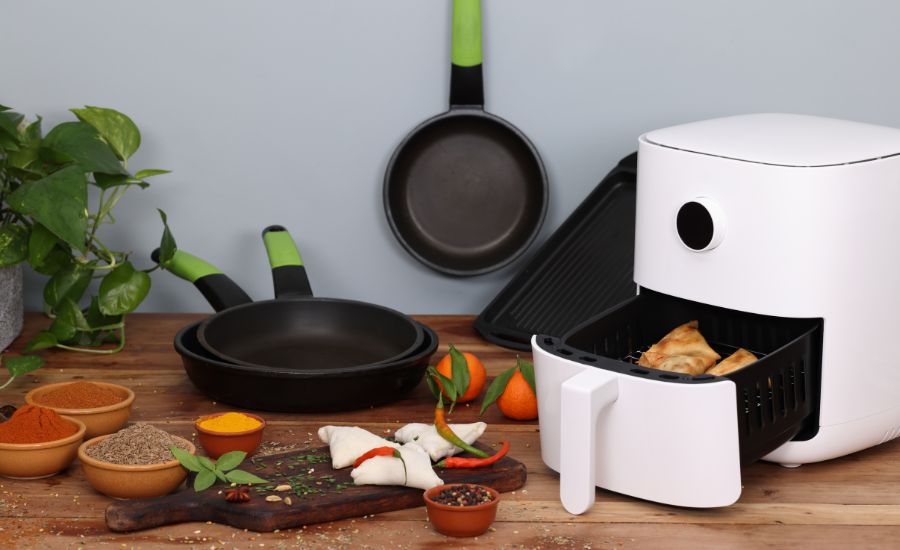
How do air fryers work?
Air fryers function based on the concept of convection cooking, where the even distribution of hot air surrounds the food for thorough cooking. Here is a more in-depth explanation of the working mechanism of air fryers:
- Heating element: Air fryers have a heating coil, usually located at the top or bottom of the appliance. When turned on, the coil begins to generate heat.
- Fan: Air fryers are equipped with a powerful fan located above the heating coil. The fan helps circulate the hot air throughout the cooking chamber.
- Air intake and exhaust: Air fryers have vents or openings that allow fresh air to enter the appliance. This fresh air is then heated by the coil and circulated by the fan. The hot air is expelled through an exhaust system, which helps maintain a constant temperature within the air fryer.
- Cooking chamber: The cooking chamber of an air fryer is where the food is placed. It typically consists of a removable basket or tray that holds the food during the cooking process. The basket or tray has perforations or mesh-like surfaces to allow the hot air to circulate around the food.
The resulting work of an air fryer is crispy, golden-brown food without the excessive greasiness associated with traditional frying methods for cooking food.
Air frying vs. deep-frying
Air fry is a healthier alternative to deep-frying as it requires little to no oil for cooking. While deep-frying involves submerging food in hot oil, air frying achieves similar results by using circulating hot air. This method significantly reduces the calorie and fat content of the food, making it a more nutritious choice.
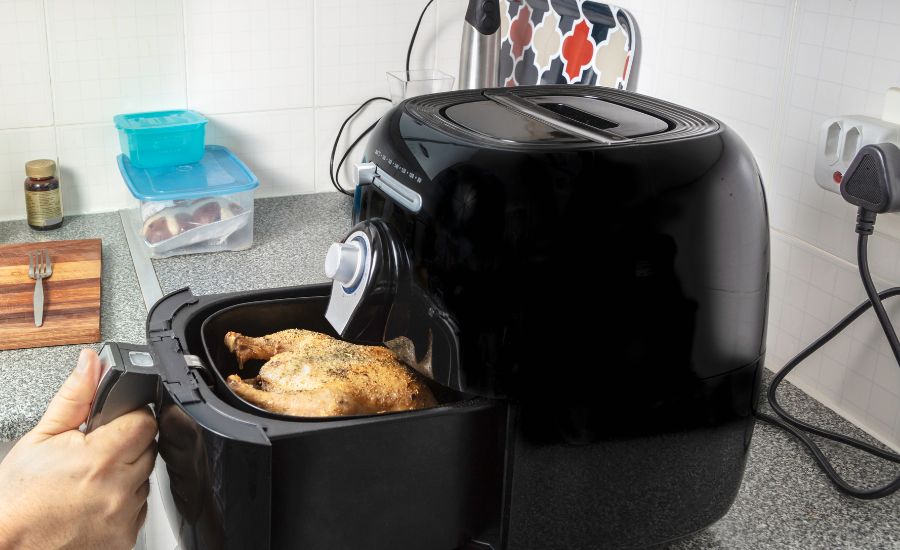
Comparing air fryers to microwaves
Microwave ovens have become a staple in kitchens around the world due to their convenience and efficiency in heating and reheating food.
Microwaves: an overview
These appliances utilize electromagnetic radiation in the microwave frequency range to generate heat within the food.
The microwave radiation penetrates the food and evenly distributes heat, resulting in uniform heating throughout. This feature makes microwaves ideal for reheating leftovers, as they can quickly bring cold food to a desired temperature without causing overcooking or drying out.
Microwaves are also commonly used for defrosting frozen food items. By adjusting the power level, users can ensure a gradual thawing process without partial cooking or compromising the quality of the food.
Another benefit of microwave ovens is their ability to heat liquids rapidly. Whether it’s reheating a cup of coffee or warming up a bowl of soup, microwaves provide a quick and convenient solution. The even distribution of heat within the liquid ensures consistent temperature throughout, making it an efficient alternative to stovetop heating.
It’s worth noting that microwaves are not suitable for all types of cooking. While they excel at heating and reheating, they may not achieve the same texture as a conventional oven, an air fryer, and even a toaster oven.
For instance, microwave cooking is not ideal for cooking crispy fried foods like french fries and deep fry food. However, they remain a valuable appliance for their quick and efficient heating capabilities.
In terms of safety, microwaves are designed with features to prevent accidents.
They include a safety interlock system that halts the operation when the door is open, protecting users from exposure to microwaves.
Additionally, the materials used in microwave construction, such as the metal cavity, are designed to contain microwave radiation and prevent leaks.
Overall, microwaves are versatile appliances that excel at rapid heating, reheating, and defrosting. Their ability to evenly distribute heat and achieve quick results make them an essential kitchen tool for many households.
While they have limitations in certain cooking applications, combining a microwave with other appliances, such as an air fryer, can provide a well-rounded cooking experience, catering to various culinary needs.
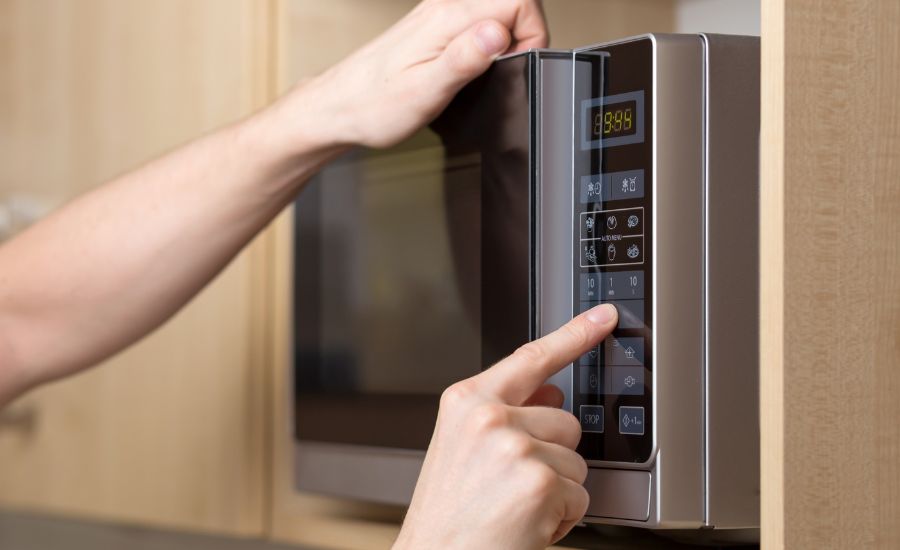
Heating methods: air fryer vs. microwave
While both appliances are capable of heating food, the methods they employ differ. The air fryer uses heating coil elements and circulating hot air to cook food, creating a crispy exterior and moist interior.
Microwaves, on the other hand, heat food by penetrating it with microwaves, resulting in a more uniform but sometimes less desirable texture.
Cooking capabilities of an air fryer
An air fryer is a versatile appliance that can cook a wide range of foods, including french fries, fried chicken, and almost any fried food at all. It excels at creating crispy textures without the need for excessive oil.
A microwave, on the other hand, is more commonly used for reheating food and defrosting and does it much better than an air fryer.
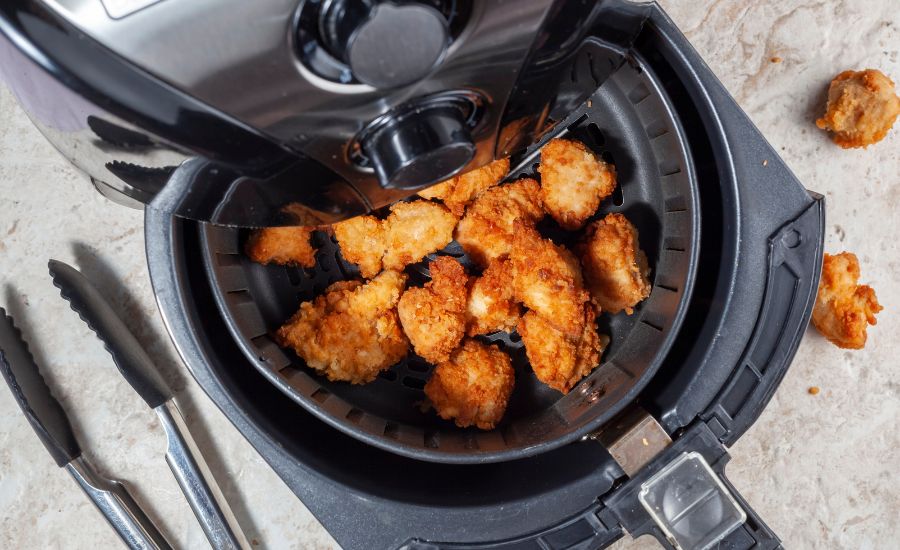
Reheating
When it comes to reheating food, the microwave oven is often the go-to choice due to its speed and convenience compared to an air fryer.
The microwave oven can evenly reheat leftovers and ensure a quick meal.
While an air fryer can also reheat food, it might take slightly longer, but the ending result is often more satisfying due to the crispness it imparts.
Can an air fryer replace a microwave?
While an air fryer offers a variety of cooking options and can potentially replace microwaves in certain scenarios, it cannot fully replace them in all aspects.
Microwaves excel at rapidly heating liquids and reheating food, making them indispensable for quick and convenient meal preparation.
However, air fryers can provide an alternative for cooking and reheating certain foods, offering a healthier approach to frying.
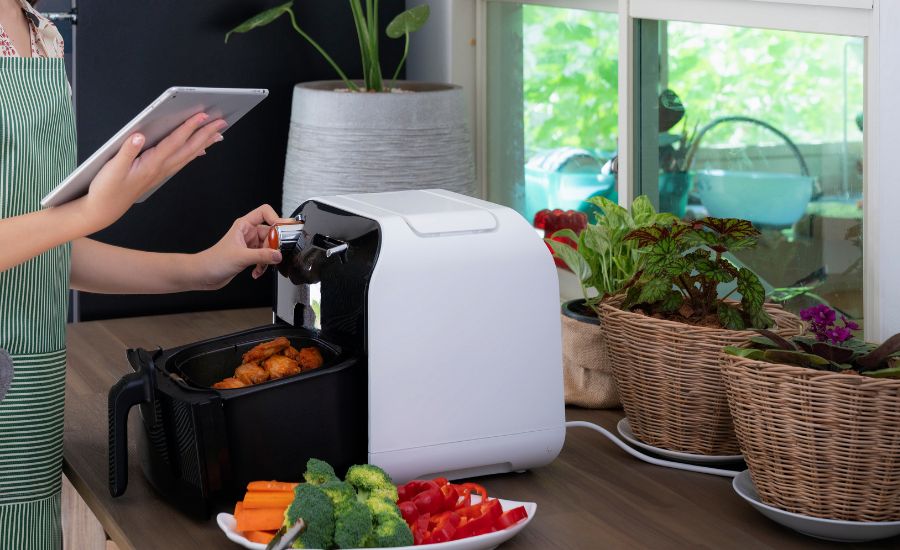
Exploring the advantages of an air fryer
Healthier cooking:
One of the primary advantages of an air fryer is its ability to cook food with significantly less oil compared to traditional frying methods. This reduction in oil intake can lead to lower calorie consumption and reduced fat intake, contributing to a healthier diet.
Versatility:
Air fryers are versatile appliances that can handle a wide range of cooking tasks. From cooking crispy fried chicken to roasting vegetables, air fryers offer a multitude of options, making them a valuable addition to any kitchen.
Energy efficiency:
Compared to microwave oven, air fryer typically exhibits higher energy efficiency.
They consume less power during operation and can often cook food more rapidly due to the intense heat generated by the circulation of hot air.
This enhanced efficiency not only helps save on energy costs but also contributes to long-term savings.
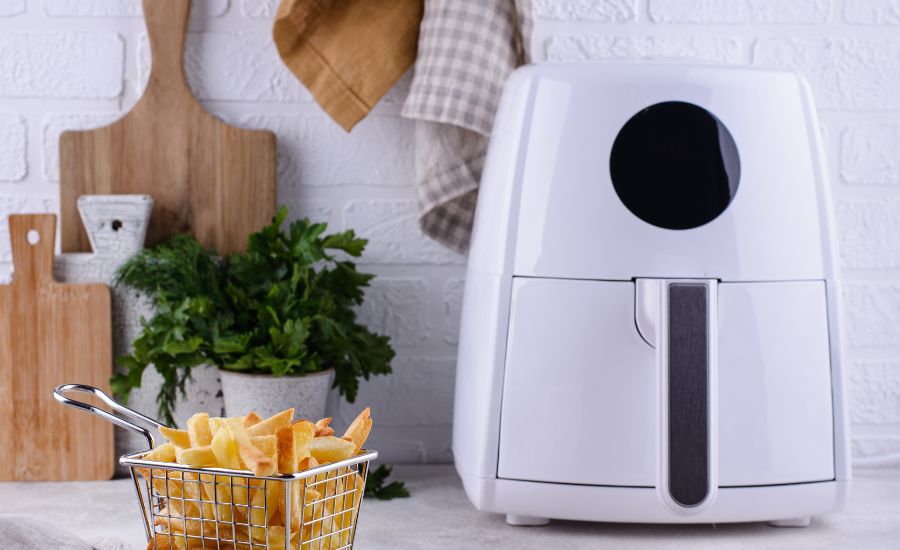
Conclusion
While an air fryer offers a range of cooking possibilities and can partially replace a microwave for certain functions, it cannot completely replace it.
Microwaves remain essential for quick heating or reheating. Overall, it will be a good choice to have not just an air fryer in your kitchen.
However, if you seek a healthier alternative for frying foods and want to expand your cooking repertoire, an air fryer can be a valuable addition to your kitchen.
Assess your cooking needs and preferences to determine whether an air fryer can complement or replace your existing appliances.
FAQ
Should I replace my microwave with an air fryer?
It depends on your specific needs. If you heavily rely on microwaves for quick heating and reheating, it is recommended to keep your microwave.
If you desire a healthier approach to frying food with minimal oil and are looking to explore alternative cooking methods, incorporating an air fryer into your kitchen repertoire can be an excellent decision.
What appliances can an air fryer replace?
Regular deep fryers can actually be replaced with air fryers for cooking fried foods, eliminating the need for excessive oil.
Also, air fryers can serve as an alternative to oven baking for certain dishes, providing a quicker and more energy-efficient cooking option.
Which is better, a microwave or an air fryer?
Your decision to choose between a microwave and an air fryer will ultimately hinge upon your individual cooking preferences and requirements. If you prioritize quick reheating of food, microwaves are an excellent choice. On the other hand, if you desire crispy, delicious foods with minimal oil usage, air fryers excel in that aspect.
Consider your priorities and desired cooking outcomes to determine which appliance suits you best – a microwave or an air fryer.
Can an air fryer be used to reheat food?
Yes, air fryer can be used to reheat food. While they may take slightly longer compared to a microwave, air fryers can reheat food while also adding a crispy texture, resulting in a more satisfying eating experience.

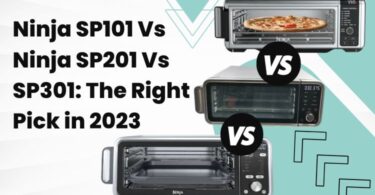

![Why Air Fryer Won’t Turn On When Plugged In? [Troubleshooting Guide] 10 air fryer won't turn on when plugged in](https://ricecreamshoppe.com/wp-content/uploads/2022/12/air-fryer-wont-turn-on-when-plugged-in-375x195.jpg)



Leave a Comment